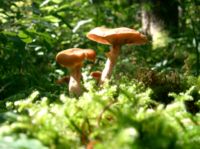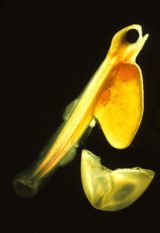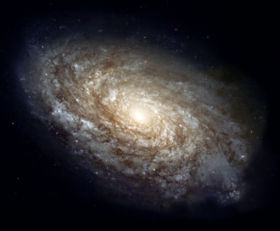Nature
2007 Schools Wikipedia Selection. Related subjects: General Biology

Nature, in the broadest sense, is equivalent to the natural world, physical universe, material world or material universe. "Nature" refers to the phenomena of the physical world, and also to life in general. The term generally does not include manufactured objects and human interaction unless qualified in ways such as, e.g., "human nature" or "the whole of nature". Nature is also generally distinguished from the supernatural. It ranges in scale from the subatomic to the galactic.
The word "nature" derives from the Latin word natura, or "the course of things, natural character." Natura was a Latin translation of the Greek word physis (φύσις), which originally related to the innate way in which plants and animals grow of their own accord, and to the Greek word for plants generally. The concept of nature as a whole, the physical universe, is a more recent development that gained increasingly wide use with the advent of modern scientific method in the last several centuries.
Within the various uses of the word today, "nature" may refer to the general realm of various types of living plants and animals, and in some cases to the processes associated with inanimate objects – the way that particular types of things exist and change of their own accord, such as the weather and geology of the Earth, and the matter and energy of which all these things are composed. It is often taken to mean the " natural environment" or wilderness – wild animals, rocks, forest, beaches, and in general those things that have not been substantially altered by human intervention, or which persist despite human intervention. This more traditional concept of natural things which can still be found today implies a distinction between the natural and the artificial, with the latter being understood as that which has been brought into being by a human or human-like consciousness or mind.
Earth
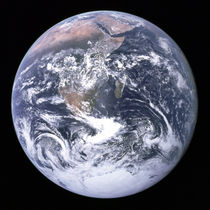
Earth (or, "the Earth") is the fifth largest planet in the solar system, third in order of distance from the Sun. It is the largest of its planetary system's terrestrial planets and the only place in the universe known to support life.
The most prominent features of the earth's climate are its two large polar regions, two relatively narrow temperate zones, and a wide equatorial tropical to subtropical region. Precipitation patterns vary widely according to location, ranging from several meters of water per year to less than a millimeter. About 70 percent of the surface is covered by salt-water oceans. The remainder consists of continents and islands, with the vast majority of the habitable land in the Northern Hemisphere.
Earth has evolved through geological and biological processes that have left traces of the original conditions. The outer surface is divided into several tectonic plates that gradually migrate across the surface over geologic time spans, which at least several times have changed relatively quickly. The interior of the planet remains active, with a thick layer of molten Earth mantle and an iron-filled core that generates a magnetic field. The atmospheric conditions have been significantly altered from the original conditions by the presence of life forms, which create an ecological balance that stabilizes the surface conditions. Despite the wide regional variations in climate by latitude and other geographic factors, the long-term average global climate is quite finely regulated, and variations of a degree or two of average global temperature have historically had major effects on the ecological balance, and on the actual geography of the Earth.
Based on the available evidence, scientists have reconstructed detailed information about the planet's past. Earth is believed to have formed about 4.55 billion years ago out of the solar nebula, along with the Sun and other planets. The moon formed relatively soon afterwards (roughly 20 million years later, or 4.53 billion years ago). Initially molten, the outer layer of the planet cooled, resulting in the solid crust. Outgassing and volcanic activity produced the primordial atmosphere. Condensing water vapor, augmented by ice delivered by comets, produced the oceans. The highly energetic chemistry is believed to have produced a self-replicating molecule around 4 billion years ago.
Continents formed, then broke up and reformed as the surface of Earth reshaped itself over the course of hundreds of millions of years, occasionally combining to form a supercontinent. Roughly 750 million years ago, the earliest known supercontinent Rodinia, began to break apart. The continents later recombined to form Pannotia which broke apart about 540 million years ago, then finally Pangaea, which broke apart about 180 million years ago.
There is significant evidence, still being discussed among scientists, that a severe glacial action during the Neoproterozoic era covered much of the planet in a sheet of ice. This hypothesis has been termed the "Snowball Earth", and it is of particular interest as it precedes the Cambrian explosion in which multicellular life forms began to widely proliferate about 530-540 million years ago.
Since the Cambrian explosion there have been five distinctly identifiable mass extinctions. The last mass extinction occurred some 65 million years ago, when a meteorite collision probably triggered the extinction of the non-avian dinosaurs and other large reptiles, but spared small animals such as mammals, which then resembled shrews. Over the past 65 million years, mammalian life diversified.
Several million years ago, a species of small African ape gained the ability to stand upright. The subsequent advent of human life, and the development of agriculture and further civilization allowed humans to affect the Earth in a relatively short timespan like no other life form had before, affecting both the nature and quantity of other life forms as well as global climate.
A 1998 survey by the American Museum of Natural History found that 70% of biologists view the present era as part of a mass extinction event, the Holocene extinction event, the fastest to have ever occurred. Some, such as E. O. Wilson of Harvard University, predict that human destruction of the biosphere could cause the extinction of one-half of all species in the next 100 years. The extent of the current extinction event is still being researched, debated and calculated by biologists.
Weather and climate
The atmosphere of the Earth serves as a key factor in sustaining the planetary ecosystem. The thin layer of gases that envelops the Earth are held in place by the planet's gravity. It consists of 78% nitrogen, 21% oxygen, and traces of other gases. The atmospheric pressure declines steadily with altitude, and has a scale height of 8.5 kilometres: the height at which the atmospheric pressure has delined by a factor of e. The ozone layer of the Earth's atmosphere plays an important role in depleating the amount of ultraviolet radiation that reaches the surface. As DNA readily damaged by UV light, this serves to protect life at the surface. The atmosphere also retains heat during the night, thereby reducing the daily temperature extremes.
Terrestrial weather occurs almost exclusively in the lower part of the atmosphere, and serves as a convective system for redistributing heat. Ocean currents are another important factor in determining climate, particularly the major underwater thermohaline circulation which distributes heat energy from the equatorial oceans to the polar regions. These currents help to moderate the differences in temperature between winter and summer in the temperate zones. Also, without the redistributions of heat energy by the ocean currents and atmosphere, the tropics would be much hotter, and the polar regions much colder.
Weather can have both beneficial and harmful effects. Extremes in weather, such as tornadoes or hurricanes and cyclones, can expend large amounts of energy in their path and produce devastation. Surface vegetation has evolved a dependence on the seasonal variation of the weather, and sudden changes lasting only a few years can have a dramatic effect, both on the vegetation and on the animals dependent on the growths for food.
The planetary climate is a measure of the long-term trends in the weather. Various factors are known to influence the climate, including ocean currents, surface albedo, greenhouse gases, variations in the solar luminosity, and changes to the planet's orbit. Based on historical records, the Earth is known to have undergone drastic climate changes in the past, including ice ages. The climate of a region is dependent on a number of factors including latitude. A latitudinal band of the surface with similar climatic attributes forms a climate region. There are a number of such regions, ranging from the tropical climate at the equator to the polar climate in the northern and southern extremes. Weather is also influenced by the seasons, which result from the Earth's axis being tilted to its orbital plane. Thus, at any given time during the summer or winter, one part of the planet is more directly exposed to the rays of the Sun (see Fig. 1). This exposure alternates as the Earth revolves in its orbit. At any given time, regardless of season, the northern and southern hemispheres experience opposite seasons.
Weather is a chaotic system that is readily modified by small changes to the environment, so accurate weather forecasting, is currently limited to only a few days. Overall, two things are currently happening worldwide: (1) temperature is increasing on the average; and (2) weather patterns are changing and becoming increasingly chaotic.
Life
The advent of photosynthesis in very basic forms of plant life worldwide allowed the sun's energy to be harvested to create conditions allowing for more complex life. The resultant oxygen accumulated in the atmosphere and gave rise to the ozone layer. The incorporation of smaller cells within larger ones resulted in the development of yet more complex cells called eukaryotes. Cells within colonies became increasingly specialized, resulting in true multicellular organisms. With the ozone layer absorbing harmful ultraviolet radiation, life colonized the surface of Earth.
Although there is no universal agreement on the definition of life, scientists generally accept that the biological manifestation of life is characterized by organization, metabolism, growth, adaptation, response to stimuli and reproduction. Life may also be said to be simply the characteristic state of organisms. Properties common to terrestrial organisms (plants, animals, fungi, protists, archaea and bacteria) are that they are cellular, carbon-and-water-based with complex organization, having a metabolism, a capacity to grow, respond to stimuli, and reproduce. An entity with these properties is generally considered life. However, not every definition of life considers all of these properties to be essential. Human-made analogs of life may also be considered to be life.
The biosphere is the part of Earth's outer shell — including air, land, surface rocks and water — within which life occurs, and which biotic processes in turn alter or transform. From the broadest geophysiological point of view, the biosphere is the global ecological system integrating all living beings and their relationships, including their interaction with the elements of the lithosphere (rocks), hydrosphere (water), and atmosphere (air). Currently the entire Earth contains over 75 billion tons (150 trillion pounds or about 6.8 x1013 kg) of biomass (life), which lives within various environments within the biosphere. Over nine-tenths of the total biomass on Earth is plant life, on which animal life depends very heavily for its existence. More than 2 million species of plant and animal life have been identified to date, and estimates of the actual number of existing species range from several million to well over 50 million. The number of individual species of life is constantly in some degree of flux, with new species appearing and others ceasing to exist on a continual basis. The total number of species presently is in rapid decline.
The distinction between plant and animal life is not sharply drawn, with some categories of life that stand between or across the two. Originally Aristotle divided all living things between plants, which generally do not move, and animals. In Linnaeus' system, these became the Kingdoms Vegetabilia (later Plantae) and Animalia. Since then, it has become clear that the Plantae as originally defined included several unrelated groups, and the fungi and several groups of algae were removed to new kingdoms. However, these are still often considered plants in many contexts. Bacterial life is sometimes included in flora, and some classifications use the term bacterial flora separately from plant flora.
Among the many ways of classifying plants are by regional floras, which, depending on the purpose of study, can also include fossil flora, remnants of plant life from a previous era. People in many regions and countries take great pride in their individual arrays of characteristic flora, which can vary widely across the globe due to differences in climate and terrain. Regional floras commonly are divided into categories such as native flora and agricultural and garden flora, the latter of which are intentionally grown and cultivated. Some types of "native flora" actually have been introduced centuries ago by people migrating from one region or continent to another, and become an integral part of the native, or natural flora of the place to which they were introduced. This is an example of how human interaction with nature can blur the boundary of what is considered nature. Another category of plant has historically been carved out for weeds. Though the term has fallen into disfavor among botanists as a formal way to categorize "useless" plants, the informal use of the word "weeds" to describe those plants that are deemed worthy of elimination is illustrative of the general tendency of people and societies to seek to alter or shape the course of nature. Similarly, animals are often categorized in ways such as domestic, farm animals, wild animals, pests, etc. according to their relationship to human life.
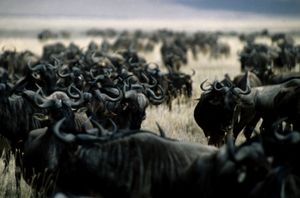
Animals as a category have several characteristics that generally set them apart from other living things, though not traced by scientists to having legs or wings instead of roots and leaves. Animals are eukaryotic and usually multicellular (although see Myxozoa), which separates them from bacteria, archaea and most protists. They are heterotrophic, generally digesting food in an internal chamber, which separates them from plants and algae. They are also distinguished from plants, algae, and fungi by lacking cell walls. With a few exceptions, most notably the sponges (Phylum Porifera), animals have bodies differentiated into separate tissues. These include muscles, which are able to contract and control locomotion, and a nervous system, which sends and processes signals. There is also typically an internal digestive chamber. The eukaryotic cells possessed by all animals are surrounded by a characteristic extracellular matrix composed of collagen and elastic glycoproteins. This may be calcified to form structures like shells, bones, and spicules, a framework upon which cells can move about and be reorganized during development and maturation, and which supports the complex anatomy required for mobility.
Although humans currently comprise only about one-half of one percent of the total living biomass on Earth, the human effect on nature is disproportionately large. Because of the extent of human influence, the boundaries between what we regard as nature and "made environments" is not clear cut except at the extremes. Even at the extremes, the amount of natural environment that is free of discernible human influence is presently diminishing at an increasingly rapid pace, or, according to some, has already disappeared.
Ecosystems

All forms of life are highly interactive with the environment in which they exist, and also with other life forms. In the 20th century this premise gave rise to the concept of ecosystems, which can be defined as any situation where there is interaction between organisms and their environment. Ecosystems are composed of a variety of abiotic and biotic components that function in an interrelated way. Some of the more important components are: soil, atmosphere, radiation from the sun, water, and living organisms. Each living organism has a continual relationship with every other element that makes up its environment. Within the ecosystem, species are connected and dependent upon one another in the food chain, and exchange energy and matter between themselves as well as with their environment. Michael Pidwirny, in Fundamentals of Physical Geography, describes the concept as follows:
Ecosystems are dynamic entities composed of the biological community and the abiotic environment. An ecosystem's abiotic and biotic composition and structure is determined by the state of a number of interrelated environmental factors. Changes in any of these factors (for example: nutrient availability, temperature, light intensity, grazing intensity, and species population density) will result in dynamic changes to the nature of these systems. For example, a fire in the temperate deciduous forest completely changes the structure of that system. There are no longer any large trees, most of the mosses, herbs, and shrubs that occupy the forest floor are gone, and the nutrients that were stored in the biomass are quickly released into the soil, atmosphere and hydrologic system. After a short time of recovery, the community that was once large mature trees now becomes a community of grasses, herbaceous species, and tree seedlings.
Every species has limits of tolerance to factors that affect its survival, reproductive success and ability to continue to thrive and interact sustainably with the rest of its environment, which in turn may have effects on these factors for many other species or even on the whole of life. The concept of an ecosystem is thus an important subject of study, as such study provides information needed to make decisions about how human life may interact in a way that allows the various ecosystems to be sustained for future use rather than used up or otherwise rendered ineffective. For the purpose of such study, a unit of smaller size is called a microecosystem. For example, an ecosystem can be a stone and all the life under it. A macroecosystem might involve a whole ecoregion, with its drainage basin.
The following ecosystems are examples of the kinds currently under intensive study:
- "continental ecosystems", such as "forest ecosystems", "meadow ecosystems" such as steppes or savannas), or agro-ecosystems,
- systems in inland waters, such as lentic ecosystem"s such as lakes or ponds; or lotic ecosystems such as rivers,
- oceanic ecosystems.
Another classification can be made by reference to its communities, such as in the case of a human ecosystem. The broadest classification, today under wide study and analysis, and also subject to widespread arguments about its nature and validity, is that of the entire sum of life seen as analogous to a self-sustaining organism, known as the Gaia theory.
Human relationship with nature
The development of technology by the human race has allowed the greater exploitation of natural resources and has helped to alleviate some of the risk from natural hazards. In spite of this progress, however, the fate of human civilization remains closely linked to changes in the enviroment. There exists a highly complex feedback-loop between the use of advanced technology and changes to the environment that are only slowly becoming understood.
Humans employ nature for both leisure and economic activities. The acquisition of natural resources for industrial use remains a primary component of the world's economic system. Some activities, such as hunting and fishing, are used for both sustenance and leisure, often by different people. the adoption of agriculture was first adopted around the 9th millennium BCE. Ranging from food production to energy, nature influences economic wealth.
Human beings have also made medicinal use of plants for thousands of years. Plant extracts can treat cramps, heal rhumatism and cure lung inflammation .. While science has enabled us to process natural substances into pills, tinctures, powders and essential oils., the market economy and the 'authority' status attributed to the medical fraternity have made their use less popular. The term alternative medicine is often attributed to the use of natural plants and extracts for healing purposes.
Manmade threats to nature include pollution, deforestation, and disasters such as oil spills. Humankind has contributed to the extinction of some plants and animals.
Wilderness
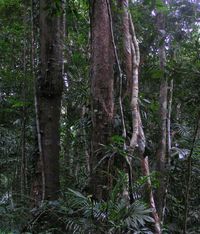
Wilderness is generally defined as a natural environment on Earth that has not been directly modified by human activity. Ecologists consider wilderness areas to be an integral part of the planet's self-sustaining natural ecosystem (the biosphere).
The word, "wilderness", derives from the notion of wildness; in other words that which is not controllable by humans. The word's etymology is from the Old English wildeornes, which in turn derives from wildeor meaning wild beast (wild + deor = beast, deer). From this point of view, it is the wildness of a place that makes it a wilderness. The mere presence or activity of people does not disqualify an area from being "wilderness." Many ecosystems that are, or have been, inhabited or influenced by activities of people may still be considered "wild." This way of looking at wilderness includes areas within which natural processes operate without very noticeable human interference.
Looked at through the lens of the visual arts, nature and wildness have been important subjects in various epochs of world history. An early tradition of landscape art occurred in the Tang Dynasty (618-907). The tradition of representing nature as it is became one of the aims of Chinese painting and was a significant influence in Asian art. Artists learned to depict mountains and rivers “from the perspective of nature as a whole and on the basis of their understanding of the laws of nature … as if seen through the eyes of a bird.” In the 13th century, Shih Erh Chi listed "scenes lacking any places made inaccessible by nature,” as one of the 12 things to avoid in painting.
In the Western world the idea of wilderness having intrinsic value emerged in the 1800s, especially in the works of the Romantic movement. British artists John Constable and JMW Turner turned their attention to capturing the beauty of the natural world in their paintings. Before that, paintings had been primarily of religious scenes or of human beings. William Wordsworth’s poetry described the wonder of the natural world, which had formerly been viewed as a threatening place. Increasingly the valuing of nature became an aspect of Western culture.
Beauty in nature
Beauty in nature is a common theme in modern life and in art, and books emphasizing beauty in nature fill large sections of libraries and bookstores. That nature has been depicted and celebrated by so much art, photography, poetry and other literature shows the strength with which many people associate nature and beauty. Why this association exists, and what the association consists of, is studied by the branch of philosophy called aesthetics. Beyond certain basic characteristics that many philosophers agree about to explain what is seen as beautiful, the opinions are virtually endless.
Many scientists, who study nature in more specific and organized ways, also share the conviction that nature is beautiful; the French mathematician, Jules Henri Poincaré (1854-1912) said:
The scientist does not study nature because it is useful; he studies it because he delights in it, and he delights in it because it is beautiful.
If nature were not beautiful, it would not be worth knowing, and if nature were not worth knowing, life would not be worth living. Of course I do not here speak of that beauty which strikes the senses, the beauty of qualities and of appearance; not that I undervalue such beauty, far from it, but it has nothing to do with science; I mean that profounder beauty which comes from the harmonious order of the parts and which a pure intelligence can grasp.
A common classical idea of beautiful art involves the word mimesis, the imitation of nature. Also in the realm of ideas about beauty in nature is that the perfect is implied through symmetry, equal division, and other perfect mathematical forms and notions.
Matter and energy
Some fields of science see nature as "matter in motion", obeying certain "laws of nature" which science seeks to understand. For this reason the most fundamental science is generally understood to be "physics"—the name for which is still recognizable as meaning that it is the study of nature.
Matter is commonly defined as the substance of which physical objects are composed. It constitutes the observable universe. According to the theory of special relativity, there is no unchangeable distinction between matter and energy, because matter can be converted to energy (see annihilation), and vice versa (see matter creation). The visible components of the universe are now believed to compose only 4 percent of the total mass. The remainder is believed to consist of 23 percent cold dark matter and 73 percent dark energy. The exact nature of these components is still unknown and is currently under intensive investigation by physicists.
The behaviour of matter and energy throughout the observable universe appears to follow well-defined physical laws. These laws have been employed to produce cosmological models that successfully explain the structure and the evolution of the universe we can observe. The mathematical expressions of the laws of physics employ a set of twenty physical constants that appear to be static across the observable universe. The values of these constants have been carefully measured, but the reason for their specific values remains a mystery.
Nature beyond Earth
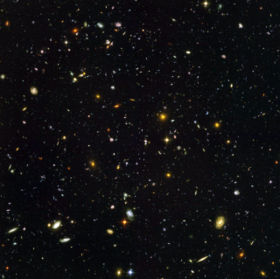
Outer space, also simply called space, refers to the relatively empty regions of the universe outside the atmospheres of celestial bodies. Outer space is used to distinguish it from airspace (and terrestrial locations). There is no discrete boundary between the Earth's atmosphere and space, as the atmosphere gradually attenuates with increasing altitude. Outer space within the solar system is called interplanetary space, which passes over into interstellar space at what is known as the heliopause.
Although outer space is certainly spacious, it is far from empty. Outer space is sparsely filled with several dozen organic molecules discovered to date by microwave spectroscopy, blackbody radiation left over from the big bang and the origin of the universe, and cosmic rays, which include ionized atomic nuclei and various subatomic particles. There is also some gas, plasma and dust, and small meteors. Additionally, there are signs of human life in outer space today, such as material left over from previous manned and unmanned launches which are a potential hazard to spacecraft. Some of this debris re-enters the atmosphere periodically.
The planet Earth is currently the only known body within the solar system to support life. However, current evidence suggests that in the distant past the planet Mars possessed bodies of liquid water on the surface. For a brief period in Mars' history, it may have also been capable of forming life. At present though, most of the water remaining on Mars is frozen. If life exists at all on Mars, it is most likely to be located underground where liquid water can still exist.
Conditions on the other terrestrial planets, Mercury and Venus, appears to be too harsh to support life as we know it. But it has been conjectured that Europa, the fourth-largest moon of Jupiter, may possess a sub-surface ocean of liquid water and could potentially host life.


